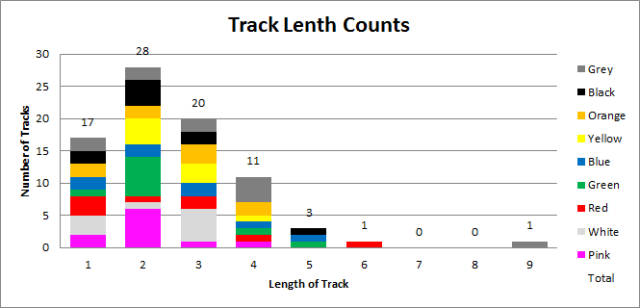Ticket to Ride: Iceland was quite a departure from my normal comfort zone in game design. Previously, I have done construction of existing rules (Arkham Horror League play), play aids (Pathfinder ACG Location Card Holder) or small extensions of existing games (Breach: Pirates and Planets). This is really the next iteration on that path in that I had a rule set to follow (Ticket to Ride: Nordic Countries), but I was effectively creating a new game that followed that rule set. Therefore, the first thing I really had to do, was to try to understand the existing rule set and try to glean what made it interesting. To begin understanding the rule set, I needed a mechanism to organize and visualize the patterns of those rules – for me, the tool of choice for this task was Microsoft Excel.
I started by cataloging every length of track from Ticket to Ride: Nordic Countries. Namely, for each track, I cataloged: the two cities it connected, the length, the color, whether it shared the path with another track, whether it was a tunnel, and how many ferry segments it contained.
Once I had this information, I could start gathering statistics: what does the distribution of track lengths look like? What about the distributions of the different colors individually?
I was also able to gather statistical data about cities. I noticed a hidden rule that no city had two tracks connected of the same color connected to it. But I also learned the average number of connections to a city, and how those are distributed.
Finally, I did similar statistical analysis of the game cards. One thing I noticed right away is that the number of points on a ticket is the shortest path between the two named cities (I don’t know whether this holds for all cards, but it did for a random sample of cards that I checked). This gave me a method to calculate the number of points on a card, and also gave me some insight into how they fit into the bigger picture of the game.
These statistics gave me a target: this was one interpretation of how Alan R. Moon described fun, balance, and game length as it relates to the Ticket to Ride: Nordic Countries rules. Therefore, one thing I could do is try to approximate these statistics – If I was able to get close enough, I could expect that Ticket to Ride: Iceland would be a similar game to Ticket to Ride: Nordic Countries. However, now I had some knobs to turn and design decisions to make of my own; given what I know about game design, my goal was to provide something new and different, but similar enough that it was still fun, balanced, and fit the expected game length.


